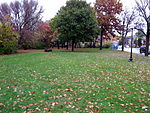Confederation Line

The Confederation Line (French: Ligne de la Confédération), also called O-Train Line 1 (French: Ligne 1 de l'O-Train), is a light rail line operated by OC Transpo in Ottawa, Ontario, Canada, as part of the city's O-Train light rail system. It opened on September 14, 2019, and is O-Train's second line. It operates on an east–west route, with a segment under Queen Street in the downtown core, complementing the north–south Trillium Line that operates to the west of the downtown core. Using light rail rolling stock and technology (e.g. pantograph electrical pickup from overhead catenary rather than a third rail), the Confederation Line is completely grade separated. The project was approved by the Ottawa City Council and the contract was awarded in December 2012. Construction began in 2013. At a cost of just over CA$2.1 billion, the first stage of the line was the largest infrastructure project awarded in the history of the city before being surpassed by the Stage 2 extension of the line, which will cost $4.66 billion.
Excerpt from the Wikipedia article Confederation Line (License: CC BY-SA 3.0, Authors, Images).Confederation Line
Nicholas Street, (Old) Ottawa Sandy Hill
Geographical coordinates (GPS) Address Nearby Places Show on map
Geographical coordinates (GPS)
| Latitude | Longitude |
|---|---|
| N 45.41905 ° | E -75.67906 ° |
Address
Nicholas Street
Nicholas Street
K1N 9A5 (Old) Ottawa, Sandy Hill
Ontario, Canada
Open on Google Maps





